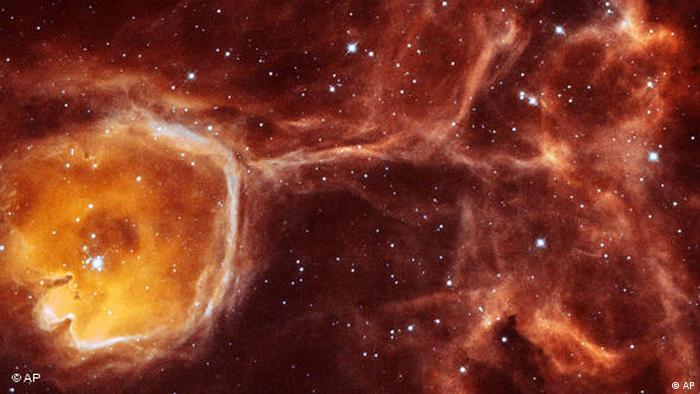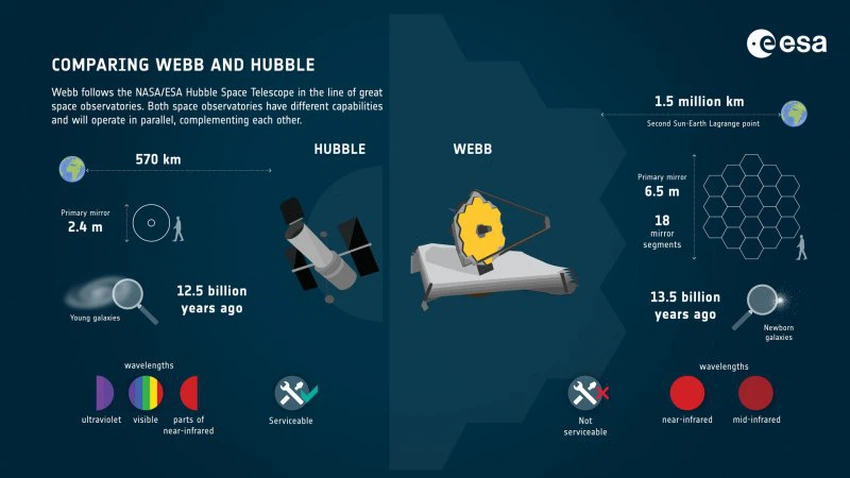31 years after launching the `Hale` telescope into space... the `James Webb` telescope comes to succeed it in revealing the secrets of the universe... so what is the difference between them?
Weather of Arabia - Over the course of 31 years, the "Hubble" telescope has deciphered many of the mysteries of the universe, from the age of the universe, to black holes, and drawing a three-dimensional map of dark matter in the universe, but many questions are still vague for astronomers, "Hubble could not Answering them, these answers require new capabilities, which is why the US Space Agency developed the first designs for the James Webb telescope shortly after the launch of Hubble in 1990 and construction began in 2004.
In an international cooperation between the US space agency "NASA" and the European and Canadian space agencies, and after more than 25 years of work in which thousands of engineers and hundreds of scientists from 14 countries participated, the James Webb telescope has become a reality.
The Webb telescope was launched into space on December 25, 2021, on board an Ariane 5 rocket from the European Space Launch Station in French Guiana, and it is scheduled to reach orbit within 4 weeks to begin its mission to probe the depths of the universe, and be the successor to “Hubble.” In exploring the universe, what distinguishes the James Webb telescope, and what is the difference between it and the Hubble telescope?
What is the difference between the James Webb telescope and the Hubble telescope?
The James Webb Telescope will challenge Hubble's supremacy and allow astronomers to image the first stars and galaxies that came into existence more than 13.5 billion years ago. James Webb will explore our solar system in fascinating new detail and study the atmospheres of distant worlds, from stars to black holes. It is the largest and most powerful space telescope ever built.
The following are the main features of the James Webb telescope and the difference between it and the Hubble Space Telescope:
sensor mirror
Hubble has a basic mirror with a diameter of (2.4) meters, while the James Webb Space Observatory has a mirror with a diameter of (6.5) meters, and it consists of 18 pieces of beryllium and is coated with a very thin layer of gold that reflects infrared rays, in order to increase its ability to see. and sensor.
The range of rays that can be detected
"Hubble" monitors the near-ultraviolet, visible, and near-infrared spectra (from 0.1 to 1 micrometer), while the James Webb telescope will detect a lower frequency range, from long-wavelength visible light to mid-infrared. (from 0.6 to 28.3 micrometers), which would allow it to detect high redshift objects that would be too old and too far from Hubble to detect.
Orbit and its distance from Earth
The “Hubble” telescope was placed in a low orbit at an altitude of approximately 600 km above the Earth, but the “James Webb” telescope will reach a point where the gravity of the Earth and the Sun are equal, called the second “Lagrangian point”, and its orbit will be about (1.5) million km away from the Earth. Three times the distance between the Earth and the Moon, there, the telescope will always be in the Earth's shadow and the instruments will have a clearer reading of the universe.
One disadvantage of this orbit is its distance from Earth, and the James Webb Telescope (JWST) would be very far from fixes like the ones tested by Hubble. This orbit is also inherently unstable, which means Webb will have to constantly adjust its speed by a few meters per second. Each year, the James Webb Telescope will spend about half an Earth year in orbit to complete one orbit.
protection shield
James Webb's detectors must operate at minus 240 degrees Celsius, and to keep it cool, Webb carries an umbrella the size of a tennis court, a protective shield made up of five flexible sails. Between each layer there is a gap so that heat can seep out from the sides. . Multiple layers also provide better protection against meteorite impact.
the size
The Hubble telescope is 13 meters long and weighs about 11 tons, while the length of "James Webb" exceeded 20 meters, but nevertheless it weighs half the weight of "Hubble".
(The figure shows the differences between "Hubble" and "Webb" in the size of the mirror - the distance from the Earth - the possibility of repair - the wavelength of the observed rays - the age of the galaxies that each can observe)
the cost
The cost of the Hubble telescope since it was built in the 1970s to date has reached $16 billion, not including all shuttles for launch and repairs. While James Webb's cost is estimated at $10 billion, it includes the first five years of operation.
label
The name of the telescope "Hubble" is inspired by the name of the American astronomer Edwin Hubble (1889 - 1953), who was the first to notice the expansion of space and contributed to understanding a lot in the field of astronomy and laid the foundation for the Big Bang theory of the universe.
The James Webb Telescope was named in honor of former NASA Administrator James Webb, as the late Webb was the appointed administrator of NASA from February 14, 1961 to October 7, 1968.
When asked about the two telescopes, Susan Mulally, deputy director of the James Webb Project at the Space Telescope Science Institute in Baltimore, said, "Comparing Hubble and Webb is like asking if you will love your second child as much as you love your first."
"Hubble will continue to be loved for the amazing images it has provided about our universe, and will continue to collect data important to astronomers, while Webb will give us a new and unique view of places we've never been able to reach."

(Hubble image of a huge gas ball that resulted from a supernova explosion, i.e. several massive star explosions)
Arabia Weather App
Download the app to receive weather notifications and more..




